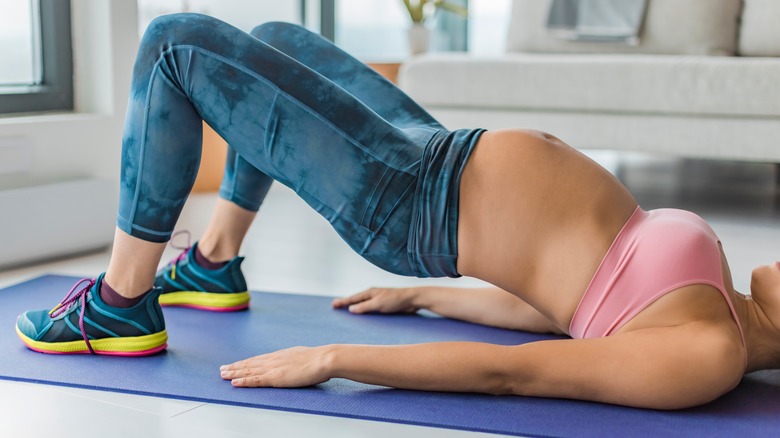Here's Why You Shouldn't Arch Your Back For An Extended Period Of Time
At some point during your early school years as a child, your teacher probably reminded you to sit up straight or cautioned, "don't slouch." At the time, this may have just felt like a bothersome reminder to pay attention. When it comes to our health, however, our posture does actually matter greatly. Not only can maintaining proper posture keep lower back pain at bay, but it also helps reduce muscle tension, fatigue, and headaches, according to experts at Lompoc Valley Medical Center. Even more, having good posture can boost our energy, breathing ability, and even our self-confidence.
Having a good posture doesn't mean that you have to keep your spine upright and rigid, though. Rather, good posture actually involves various parts of the body. This includes keeping your chin in parallel alignment with the ground, your hips and shoulders even, your body weight over your feet, and your spine in a neutral position (via Harvard Health Publishing). This means that you aren't over-stretching the natural curvature of your spine, as doing so can pose potential health problems.
You may develop hyperlordosis
While not particularly harmful in the short-term, purposefully arching your back for an extended time can lead to muscle loss in the back and legs down the line, according to Healthline. Not to mention, ongoing pain. Otherwise known as hyperlordosis, poor posture may also cause your spine to maintain an overarched position as time goes on, which can increase your likelihood of a slipped disk, stress fractures, or other spinal injuries. Additionally, because overarching your back strains your trunk, hamstring, and thigh muscles, you may end up with lower back pain or negative effects on your balance or stride. Those who are pregnant, engage in a sedentary lifestyle, or wear high heels on a long-term basis may be more susceptible to hyperlordosis. Additional risk factors include having weak core muscles, as well as certain health conditions, such as osteoporosis or cerebral palsy.
For these reasons, it's important to maintain a neutral spine position as best we can. However, this is easier said than done in certain instances, particularly during certain forms of exercise like weightlifting. To help you, try this trick. Associate clinical professor at UCSF Kenneth Leung writes via Built Lean to have someone strap a piece of tape across your lower back while standing. As you exercise, the tape will either tighten or cave in on your skin if you're overarching your back in either direction. While some movement will be natural, try and keep the tape steadily in place.
Stretches to ease overarching
If you struggle with back pain on an ongoing basis, be sure to speak with your physician. In some cases, medication, physical therapy, or a back brace may be required depending on the cause (via Healthline). Lifestyle changes may be recommended for others.
Alternatively, try making time for some light stretching on a regular basis to help keep your lower back muscles relaxed. This includes pelvic bridges, as well as knee-to-chest stretches that can be performed with either one or both knees while laying on the ground. For those with hyperlordosis specifically, know that there are stretches that may help reduce excess curvature. Experts at The Spine Center suggest certain yoga poses, such as the cobra pose or child's pose. You can also try abdominal crunches or pelvic tilts while sitting on a physiotherapy ball. The important thing to remember is no matter where you are — whether you're sitting, standing, or exercising — try and always keep your spine as neutral as possible to prevent problems later on.



